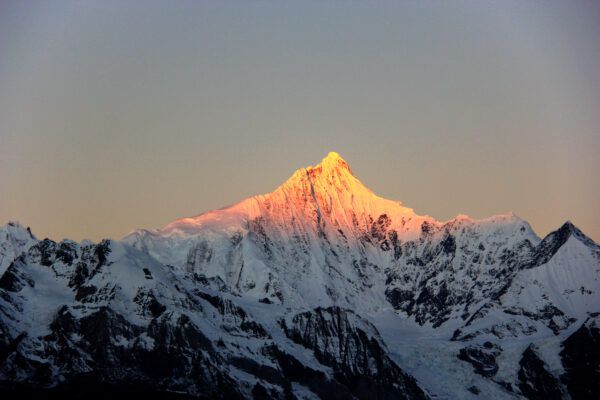Modern Chinese place names that reflect ancient history and traditional naming conventions
“May your happiness be as boundless as the East Sea, and may you live as long as the Zhongnan Mountains (福如东海长流水,寿比南山不老松).” This traditional Chinese birthday blessing given to the elderly reveals the cultural significance of two geographic locations—the East Sea and the Zhongnan Mountains—but it also hints at the origins of many present-day Chinese place names.
Chinese place names evolved over many centuries, and often reflect ancient naming traditions and culture. For example, literary classics have long referred to the seemingly endlessly vast expanse of the East Sea as a metaphor for immense pleasure and long life. The first half of the popular birthday message first appeared in the Ming dynasty (1368 – 1644) classic novel Journey to the West (《西游记》): “His happiness is as boundless as the East Sea, and he seems as healthy as a child (福如东海长流水,貌似小童身体健).”
In ancient Chinese literature and mythology, four metaphorical seas to the north, east, south, and west were invoked to represent the borders of Chinese civilization. It was not until empires expanded to real bodies of water that these “seas” became true boundaries.
Donghai county (东海县, “East Sea county”) in today’s Jiangsu province got its name in the early 20th century based on a story about Qin Shihuang, founder of the Qin dynasty (221 – 206 BCE) and first ruler of a unified China. When Qin Shihuang’s forces made it to the ocean in the east, they declared this the boundary of their realm and gave the name Donghai to what was then Qu (朐) county. The historian Sima Qian (司马迁) recorded the event in his Records of the Grand Historian (《史记》): “A stone monument erected at the edge of Qu was considered the boundary of the Qin empire (立石东海上朐界中,以为秦东门).”
Reverence for the Zhongnan Mountains as a symbol for eternal life goes back a similarly long way. Perhaps the earliest example of this is from Classic of Poetry (《诗经》), composed over 2,000 years ago: “Like the moon waxing to its full size, like the sun on the rise, like the Southern mountain that is divine, you will never fall or decline (如月之恒, 如日之升, 如南山之寿, 不骞不崩).”
The mountains, located in present day Shaanxi province, were a popular spot for Daoist and then Buddhist monks to live the hermit life and cultivate their characters, adding to its mystique. The Zhongnan Mountains’ proximity to the ancient capital Chang’an (present day Xi’an) also made it a useful hideout spot for officials fleeing punishment from the imperial court—a tactic that may literally have prolonged their lives.
Auspicious visions can also be found in place names in remote areas, like Kangding (康定) in Sichuan, and Diqing prefecture (迪庆州) in Yunnan. Kangding was previously known as “Dajianlu (打箭炉),” or “Firing Arrows Furnace,” a name which emerged during the Three Kingdoms period (220–280). To suppress a rebellion in the south, politician Zhuge Liang dispatched his general Guo Da to the region to make arrows for his army there, and the name stuck.
Kangding’s location made it an important strategic destination, lying on the historical border with ancient Tibet, and was known as “the hub between Sichuan and Tibet (川藏要冲)”. However, it was not until 1908 that the city was renamed Kangding. “Kang (康)” denoting the Chinese name for the region, and “Ding (定)” for stability.

Meili Snow Mountains in Diqing
Located in the junction area of Yunnan, Sichuan, and Tibet as well as at the southern tip of Qinghai-Tibet Plateau, Diqing in Tibetan has means “an auspicious place.” Here, tourists can experience spectacular scenery at “the intersection of three mountains and two rivers (三山挟两江)”: the Meili Snow Mountains (梅里雪山), Yunling Snow Mountains (云岭雪山), and the Zhongdian Snow Mountains (中甸雪山), together with the Lancangjiang River (澜沧江) and the Jinsha River(金沙江).
Place names are not always rooted in ancient Chinese tradition, however. Diqing was only established as a prefecture in 1957, and its name was given to it by the first governor. In 2001, in the hope of attracting tourism, Zhongdian county in Diqing was renamed Shangri-La (香格里拉) after the fictional paradise described by British writer James Hilton in his 1933 novel Lost Horizon. Even before this, though, ancient Tibetan scriptures had talked of a utopia like what Hilton described, describing it as “the sun and moon in ones heart (心中的日月)” (both the sun and moon are holy symbols among Tibetans).
Shangri-La nowadays has become associated with the The Peach Blossom Spring (《桃花源記》), a fable describing a hidden utopia written by Tao Yuanming (陶渊明) in 421. While Yunnan’s Shangri-La is more tourist town than heaven on earth these days, the sentiment lives on in its reputation, name…and marketing.
All images from VCG











